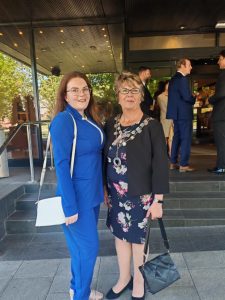When dancer Katie-Marie Martin performs in a production, little do the audience know what she has been through just to be on stage.
Katie-Marie, the daughter of Torpoint’s mayor Julie Martin, has made a remarkable return to performing after surviving an extremely rare form of spinal sarcoma cancer called a sacral chordoma, which affects just one in a million people worldwide.
Katie-Marie, 27, from Torpoint in Cornwall, first noticed something was wrong when she had back pain. Her physio thought she might have a slipped disc. Katie couldn’t sleep, and her mother, Julie, paid for her to have an MRI scan. It revealed an 11cm tumour in her spine. Katie was referred for a consultation and biopsy and was diagnosed with chordoma.
As a professional dancer at the time, this was shattering news for Katie, especially as she had a new job lined up. Her illness took a big toll on her mobility and strength, leaving her reliant on crutches.
Doctors decided against surgery; instead, Katie was to receive proton beam therapy at University College Hospital in London. This is a type of radiotherapy that uses protons, instead of X-rays, to target and destroy cancer cells. Before this, to preserve her fertility from radiation, Katie had a procedure to move her left ovary into her hip area. Given how rapidly the tumour was growing, doctors were keen to start the proton beam therapy quickly, and, for the next six weeks between June and August, Katie had two treatments a day.
After the treatment finished, scans found that, to Katie’s delight, the therapy had stopped the tumour growing. Subsequently, the tumour – which Katie had nicknamed ‘Timmy’ – shrank to roughly a third of the size it had been. Katie still has the tumour, ‘and probably always will’ she says. Annual scans for the next ten years will monitor her health. Given how much proton beam therapy she has already received, it is unlikely she will be able to have any more due to the impact on her body.
Of her wellbeing, she said: ‘I lost lots of muscle during my treatment. I have less mobility and can’t go for a run because I don’t have the stamina.’
She revealed it also affected her emotionally and she received counselling for 18 months.
Despite her adversity, Katie, 27, returned to the stage just three months after her proton beam therapy finished. Since then, she has performed in six different amateur productions and has also started to teach dance.
She said that producers make minor adaptations to her routines to make it easier for her to take part. ‘I do get tired easily, but I’d rather do something to warrant being tired than just be tired from being ill.’ She added: ‘I limit myself, so I can overachieve.’
Her mother, Julie, said: ‘Katie has always been really strong and pragmatic. I have always taken my lead from her. The fact that she is back doing what she loves is great.’ Julie is Torpoint’s Mayor and she and other family members have supported fundraising events for charity Sarcoma UK, which the town has got behind.
Katie gained a considerable following on Instagram and YouTube where she documented her illness under the name Chordoma Katie. In 2023, she won the Young Sarcoma Voice category at charity Sarcoma UK’s Shining Star Awards for helping to raise awareness of the disease.
Kate Quillin, Acting Head of Research at Sarcoma UK, said: ‘Katie-Marie’s story highlights the urgent need for new treatments for chordoma patients. While Katie-Marie has responded well to proton beam therapy, we know this treatment isn’t suitable for everyone. That’s why we’ve funded research by Professor Adrienne Flanagan at the Royal National Orthopaedic Hospital into potential drug treatments targeting the brachyury protein, which is essential for chordoma cells to survive. Research into key drivers of sarcoma could open the door to new treatment options for the thousands of people worldwide living with this devastating diagnosis, giving patients like Katie-Marie even more reason for hope.’













